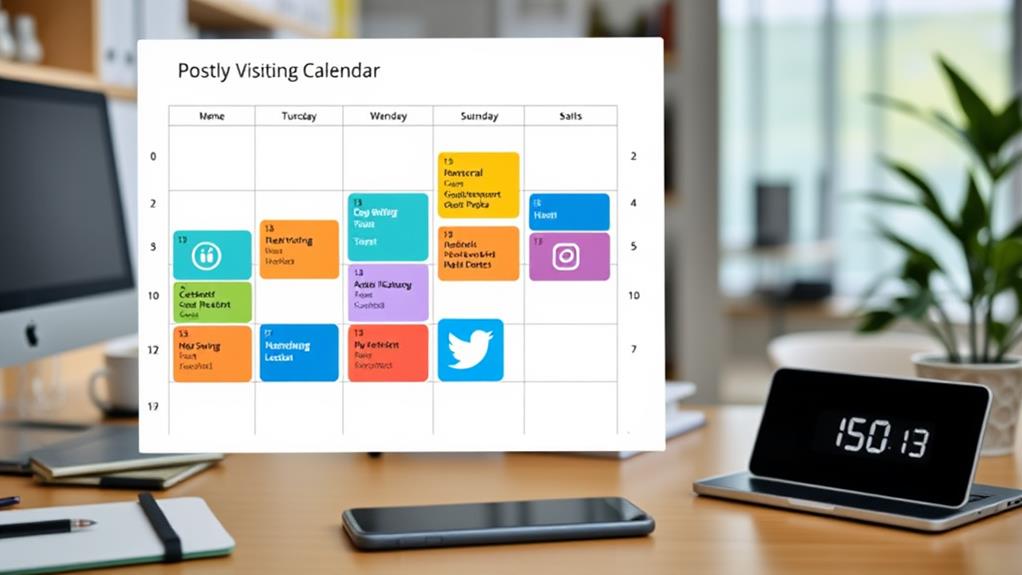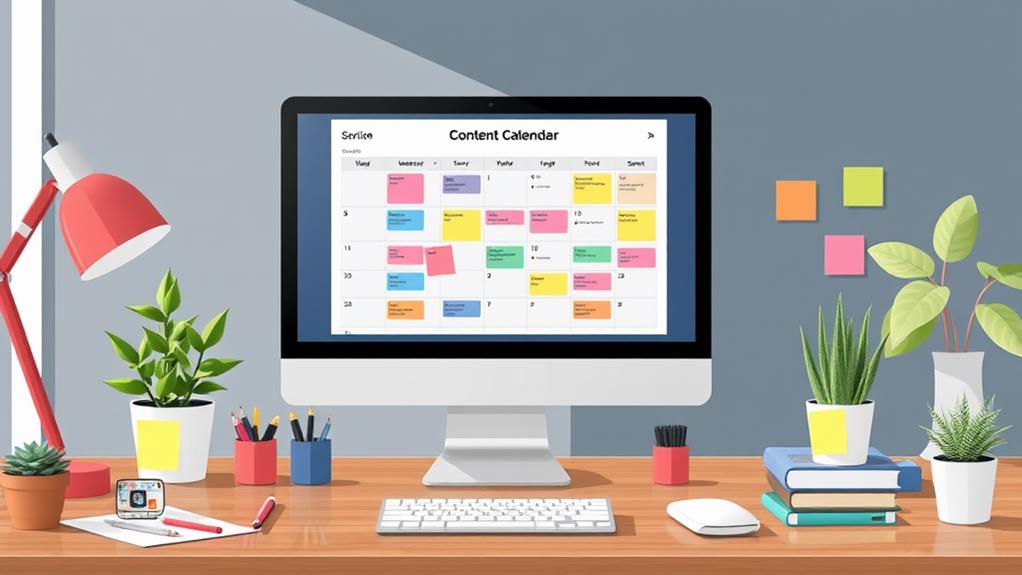Developing a social media content calendar for your small business involves several key steps. First, define clear social media goals that align with your overall business objectives. Next, identify and analyze your target audience to tailor your content effectively. Conduct an audit of current social media efforts to understand what's working and what needs improvement. Choose the right platforms based on where your audience is most active. Establish content pillars to guide your content strategy, and design a template for consistent execution. Finally, schedule your posts and monitor performance to optimize your strategy continuously. By mastering these steps, you can greatly enhance your social media presence.
Key Takeaways
- Define clear social media goals aligned with business objectives using SMART criteria.
- Identify and analyze your target audience through demographics, behaviors, and platform preferences.
- Audit current social media efforts using engagement metrics and analytical tools.
- Select suitable platforms based on target audience demographics and platform strengths.
- Establish content pillars and create a balanced posting schedule based on engagement analytics.
Define Your Social Media Goals
To develop an effective social media content calendar, it is crucial to start by defining your social media goals. Clearly articulated goals provide a solid foundation for your overall social media strategy.
Begin by outlining your business objectives, such as increasing brand awareness by 30% or generating 20% more leads through social media within the next quarter. Additionally, considering audience preferences and engagement levels can greatly impact your content strategy. These objectives should be translated into specific, measurable, attainable, relevant, and time-bound (SMART) goals.
By setting SMART goals, you guarantee that each goal aligns with your broader business strategy, thereby creating goal alignment across your organization. For instance, if increasing brand awareness is a primary objective, measurable metrics such as engagement rates and follower growth will be essential to track.
Similarly, if lead generation is the focus, metrics like click-through rates and conversion rates become crucial. Monitoring key performance indicators (KPIs) related to your defined goals allows you to assess the effectiveness of your social media initiatives.
Regularly reassessing these goals based on performance data and industry trends guarantees that your strategy remains competitive and responsive to your audience's needs. This structured approach enables you to create a dynamic and effective social media content calendar.
Identify Your Target Audience
Understanding your target audience is a critical step in crafting an effective social media content calendar. Audience segmentation allows you to tailor your content by analyzing demographic trends such as age, gender, income level, and location.
Utilizing tools like Google Analytics and social media insights can provide valuable data on your audience's interests, behaviors, and engagement metrics. Creating detailed buyer personas is essential for persona development; these personas encapsulate your ideal customers, highlighting their pain points, motivations, and preferred social media platforms.
This strategic approach guarantees that your content resonates with your target demographic. Incorporating behavior analysis helps in understanding how your audience interacts with your content, providing insights into their content preferences.
To further enhance your strategy, you can map your content to different stages of the customer journey, guaranteeing it addresses their needs at each stage. Engagement metrics and feedback mechanisms, such as surveys or polls, offer direct engagement with followers to gather feedback about their preferences and interests.
Additionally, competitor analysis is invaluable; monitoring competitor audiences and their engagement strategies allows you to identify gaps and opportunities, guaranteeing your content stands out.
Audit Current Social Media Efforts
A thorough audit of your current social media efforts serves as the foundation for refining your content strategy.
Begin by evaluating engagement metrics such as likes, shares, comments, and follower growth over the past six months. This will help identify trends and pinpoint areas for improvement.
Utilize analytical tools like Facebook Insights, Twitter Analytics, or Sprout Social to assess the performance of different content types, determining which resonate best with your audience.
Additionally, consider using audience segmentation to categorize your followers into distinct groups based on demographics and behavior. This step can further refine your strategy by tailoring content to specific audience segments.
To gain deeper audience insights, create detailed buyer personas using demographic data and psychographics derived from your existing follower base. This step is essential for tailoring your content to meet the interests and needs of your audience.
Additionally, review your posting frequency and timing to guarantee you are maximizing reach and engagement. Comparing your metrics against industry benchmarks can provide valuable context.
Finally, analyze the effectiveness of your current content themes and messaging to guarantee alignment with your business goals and audience interests.
Here's a step-by-step approach:
- Evaluate Engagement Metrics: Analyze likes, shares, comments, and follower growth.
- Utilize Analytical Tools: Use platforms like Facebook Insights and Twitter Analytics.
- Review Content Themes: Ensure your messaging aligns with business goals.
This organized approach will guide you in optimizing your social media strategy effectively.
Choose the Right Platforms
To effectively choose the right platforms for your social media content calendar, begin by evaluating where your target audience spends their time online, ensuring alignment with your business goals.
Next, analyze the strengths of each platform, considering engagement metrics and unique content formats.
Make sure to track key performance indicators, such as Engagement Rate and Click-Through Rate (CTR), to gauge platform performance.
Evaluate Audience Demographics
Evaluating audience demographics is a pivotal step in choosing the most effective social media platforms for your marketing strategy. Understanding key factors such as age preferences, gender insights, and location targeting can greatly enhance your audience segmentation efforts.
For instance, Instagram, where 71% of users are under the age of 35, is ideal for brands targeting younger consumers. In contrast, LinkedIn, preferred by professionals aged 30 to 65, is more suited for B2B marketing. Facebook, with its wide demographic appeal, particularly those aged 25 to 54, serves as a versatile platform for various audience segments.
To effectively evaluate your audience's demographic trends and behavior patterns, consider the following steps:
- Conduct Surveys: Gather detailed data on your target audience's interests and platform usage through surveys to refine your target profiling.
- Utilize Analytics Tools: Leverage social media analytics tools to gain insights into engagement metrics and demographic trends, helping you identify where your audience is most active.
- Analyze Behavior Patterns: Study engagement metrics and behavior patterns to determine which platforms align best with your audience's preferences and interests.
Analyze Platform Strengths
Understanding your audience is only the beginning; the next step involves strategically analyzing the strengths of each social media platform to choose the right ones for your brand. Each platform comes with unique characteristics and user engagement levels that can greatly impact your content strategy.
For instance, with 69% of U.S. adults using Facebook, it's ideal for reaching a broad audience, while Instagram's 37% user base is perfect for visually-driven brands.
If your brand targets younger audiences, TikTok's strong Gen Z presence (60% of users aged 16-24) offers considerable engagement opportunities. Similarly, LinkedIn is invaluable for B2B companies seeking professional connections.
Twitter, known for its high engagement rates, especially with image-based tweets, can amplify your brand's message efficiently.
Consider the type of content that thrives on each platform. Video content, which generates 1200% more shares than text and images combined, excels on platforms like YouTube and TikTok.
Pinterest and Instagram, with their focus on visuals, are excellent for brands emphasizing aesthetic appeal. By understanding platform characteristics and user engagement, you can tailor your content and maximize your social media ROI.
Align With Business Goals
Aligning your social media strategy with your business goals is essential for maximizing the impact of your online presence. To achieve effective content alignment and goal integration, start by identifying your business objectives. Whether your aim is to increase brand awareness or drive sales, selecting the right platforms is vital.
- Identify Target Audience: Utilize demographic insights to determine where your audience is most active. For instance, 73% of adults aged 18-29 use Instagram regularly, making it ideal for targeting younger consumers.
- Evaluate Content Formats: Different platforms excel with specific content types. Twitter users prefer visual content, while LinkedIn is suited for professional posts. Focus on platforms that complement your content strategy and support your goals.
- Analyze Competitor Activity: Assess how competitors use different platforms. This data-driven approach helps identify channels that yield the highest engagement and conversion rates, ensuring your efforts are concentrated on productive avenues.
Consider the resources available for content creation and management. TikTok requires dynamic, creative content, whereas Facebook supports longer-form content and community engagement.
Select Content Pillars

To effectively kick off your social media content calendar, pinpointing your content pillars is essential. Content pillars are the core themes or topics that guide your social media strategy. They guarantee that your posts remain consistent and relevant to your audience's interests.
Typically, establishing 3-5 content pillars allows for a balanced content mix, generally incorporating 2/3 informational content and 1/3 promotional material. This content balance helps avoid audience fatigue and keeps your followers engaged.
Each content pillar should align with your business goals and resonate with your target audience. By addressing their needs and preferences, you can craft content that not only captivates but also adds value.
Regularly reviewing and adjusting your content pillars based on engagement metrics will enhance the efficiency of your strategy. This practice guarantees your content remains aligned with current trends and audience interests. Consistency in posting and maintaining high-quality visuals can also greatly boost engagement rates.
To keep things organized, consider using tools like Google Sheets or Notion to visually map out your content themes. This method makes it easier to plan and organize posts around these themes within your social media calendar, guaranteeing that your brand messaging remains consistent and impactful.
Gather Content Resources
A robust social media content calendar hinges on the quality and variety of your content resources. To keep your posts fresh and engaging, compile a diverse range of materials, including user-generated content, industry news, and relevant articles. This approach not only broadens your content repertoire but also fosters audience participation and engagement.
Remember to track engagement metrics such as likes, comments, and shares to refine your content and increase visibility.
To streamline your content curation process, consider the following steps:
- Leverage Tools: Utilize platforms like Canva and Unsplash for high-quality visuals that enhance your visual storytelling without additional costs. These tools help you maintain a visually appealing and consistent feed.
- Create a Shared Folder: Establish a shared drive where team members can upload and access content resources. This promotes creative collaboration and guarantees that everyone can contribute and utilize materials effectively, enhancing resource sharing.
- Stay Updated: Use social listening tools to stay informed about trending topics and hashtags within your industry. Understanding current industry trends will help you tailor your content creation and engagement strategies more effectively.
Regularly review your content resources to identify gaps and areas for improvement. By staying organized and proactive in your content approach, you can enhance your overall strategy and drive meaningful audience engagement.
Create a Posting Schedule

Crafting an effective social media posting schedule is crucial for maintaining consistent engagement with your audience. Begin by analyzing your audience's active times through engagement metrics. This data will help you determine the ideal days and times for posting, maximizing visibility and interaction.
For instance, on LinkedIn, you might find that mid-morning on weekdays garners the highest engagement. Tailoring your schedule to these peak times can greatly enhance your post reach.
To achieve posting consistency, aim for a balanced frequency. For platforms like Facebook and Instagram, posting 3-5 times a week is recommended, though adjustments should be made based on platform norms and audience response. This guarantees your presence is regular but not overwhelming.
In addition, diversify your content types within the schedule. Allocate approximately 60% for engaging or informative content and 40% for promotional posts. This mix keeps your audience interested and prevents your feed from becoming overly commercial.
Regularly review and adjust your posting schedule based on performance analytics. This ongoing evaluation helps you refine your strategy, making sure your content remains relevant and continues to drive audience engagement.
Utilize Planning Tools
Maintaining a consistent and effective posting schedule is only part of the equation; leveraging the right planning tools can considerably enhance your social media strategy. Using tools like Google Sheets, Buffer, and Notion can streamline your content creation process, facilitate team collaboration, and improve visual planning.
- Google Sheets: Its free, cloud-based capabilities make it an excellent tool for team collaboration. Share and update your social media calendar in real-time, ensuring everyone is aligned on upcoming posts and strategies.
- Buffer: Known for its user-friendly scheduling interface, Buffer allows you to manage multiple social media accounts in one place. This not only enhances scheduling efficiency but also aids in analytics tracking, providing insights into audience engagement.
- Notion: This customizable platform is ideal for organizing your social media content calendar. Create unique templates tailored to your specific business needs, enabling effective content repurposing and platform integration.
Additionally, consider tools like Hootsuite for bulk posting and detailed performance analytics, and Sprout Social for its real-time interactive dashboard.
Design a Content Template

When designing a content template for your social media calendar, it's essential to incorporate key elements that guarantee consistency and clarity in execution. To achieve this, start with template customization, ensuring it includes essential details such as publication date, time, social media platform, post copy, visuals, hashtags, and any necessary links.
Additionally, consider optimal post timing for maximum reach based on audience activity. For enhanced visual organization, implement a color-coding system to categorize content types—promotional, informational, and engagement-driven. This allows for quick reference and helps maintain a balanced content mix.
Equally important is incorporating sections for audience engagement tracking. Monitoring metrics like comments and shares provides insights into the effectiveness of each post, helping to refine future strategies.
Including a column for performance tracking is critical. This allows for ongoing evaluation of post metrics, helping you understand what resonates most with your audience and adapt your content accordingly.
Additionally, a well-designed content template greatly improves scheduling efficiency, enabling small businesses to plan and execute campaigns without missing any critical tasks.
Schedule Your Posts
To maximize engagement, schedule your posts at ideal times specific to each platform, such as weekdays between 10 AM to 2 PM for Instagram.
Utilize social media calendar tools to automate and visualize your schedule, ensuring seamless management across multiple channels.
Regularly analyze post performance to refine your timing strategy and maintain a consistent content flow.
By using these tools, you can also experiment with interactive content like polls and quizzes to keep your audience engaged.
Keep an eye on the performance data to understand audience preferences and identify top-performing posts for insights and trends.
Optimize Posting Times
Enhancing posting times is a critical component of an effective social media strategy, directly influencing audience engagement and content reach. Understanding engagement trends and adjusting your posting frequency accordingly can greatly enhance the visibility and impact of your content.
To determine the best times to post, consider the following steps:
- Analyze Engagement Metrics: Utilize tools like Buffer and Hootsuite to gain insights into your audience's activity patterns. These platforms can provide historical data to identify ideal posting times, typically indicating that posts on weekdays, especially Wednesdays and Thursdays, achieve higher engagement rates.
- Leverage Peak Interaction Periods: Research suggests that posts made between 9 AM and 12 PM often generate the most interaction. Users are more likely to engage with content during their morning breaks, making this window a prime time for posting.
- Conduct A/B Testing: Experiment with different posting times and conduct A/B tests to gather specific insights into your audience's behavior.
Regularly reviewing your social media analytics will help identify shifts in activity patterns, enabling you to refine your posting schedule for maximum impact.
Automate Content Scheduling
Automating content scheduling is a strategic move that can greatly enhance the efficiency and effectiveness of a social media marketing plan. By pre-planning and queuing posts, small businesses can free up valuable time for other marketing activities, leading to a notable 30% increase in engagement rates.
Tools like Buffer and Hootsuite offer user-friendly interfaces that allow for scheduling across multiple platforms simultaneously, guaranteeing consistent visibility without the need for manual effort.
Utilizing features such as bulk scheduling in Hootsuite can considerably speed up the content management process. Businesses can upload and schedule multiple posts at once, which not only expedites the workflow but also ensures a steady flow of content.
This reduces the reliance on last-minute posts that may be of lower quality and less effective in driving engagement.
Setting ideal posting times based on audience insights is another pivotal aspect of automating content scheduling. By targeting peak engagement hours, businesses can boost post visibility by up to 50%, as industry studies suggest.
This strategic approach guarantees that posts reach the largest possible audience, maximizing the impact of your engagement strategies and overall social media presence.
Monitor and Analyze Performance

Effectively monitoring and analyzing performance is essential for the sustained success of your social media efforts. Regularly tracking engagement metrics such as likes, shares, comments, and click-through rates allows you to evaluate the effectiveness of your social media posts and campaigns.
Utilize analytics tools like Google Analytics or platform-specific insights to gather valuable audience insights and identify trends in behavior and preferences. Consistent analysis helps in making data-driven decisions that are vital for optimizing your content strategy. By exporting data for in-depth performance analysis, you can better understand detailed metrics such as reach and demographics.
To guarantee a structured approach, consider the following steps:
- Set Specific KPIs: Define clear Key Performance Indicators (KPIs) for each campaign to measure success against your goals. Monitor these KPIs consistently to guarantee alignment with your overall business objectives.
- Conduct Data Reviews: Perform monthly or quarterly reviews of your social media performance data. These data reviews will help you identify patterns, successes, and areas for improvement, enabling you to make informed content adjustments.
- Analyze Content Performance: Evaluate the performance of different content types such as videos, images, and articles. This campaign analysis will help determine which formats resonate most with your audience, allowing for strategic content mix adjustments.
Adjust and Optimize Strategy
Building on the insights gathered from monitoring and analyzing your social media performance, it becomes vital to adjust and optimize your strategy to maintain and enhance engagement. Regularly analyzing engagement metrics such as likes, shares, and comments is essential for identifying content that resonates with your audience, facilitating effective content refinement.
By leveraging data on posting times and audience interactions, you can adjust your publishing schedule, guaranteeing your posts reach maximum visibility during peak engagement hours. Incorporate strategies like visual storytelling techniques to create mesmerizing content that maintains viewer attention and adds depth to your messaging. Additionally, integrating trending sounds and content can further enhance your posts' appeal and relevance.
Incorporating seasonal trends and popular topics that align with your brand helps keep your content relevant and engaging. Monitoring trends and feedback enables you to adapt your content themes accordingly.
Implementing A/B testing for various content formats and messaging allows you to evaluate performance variations, making informed, data-driven decisions for future posts.
Fostering a culture of continuous improvement is essential. Schedule regular performance reviews to proactively adjust your strategy based on real-time data and audience preferences. This approach guarantees that your social media efforts remain dynamic and effective, constantly evolving to meet the needs and interests of your audience.
Frequently Asked Questions
How Do I Create a Social Media Calendar for My Small Business?
To create a social media calendar for your small business, conduct a social media audit, define content pillars, and establish posting frequencies. Incorporate seasonal themes and regularly analyze performance metrics to optimize audience engagement and strategy effectiveness.
How Do I Create a Social Media Plan for My Small Business?
To create a social media plan for your small business, define your target audience, establish clear goals, and develop content themes. Regularly analyze performance metrics to refine your strategy and guarantee continuous engagement and growth.
How Do I Create Social Media Content for My Business?
To create social media content for your business, implement engagement strategies by identifying key content themes that resonate with your audience. Use analytics to refine your approach, incorporating diverse formats to maximize reach and engagement.
What to Include in a Social Media Content Calendar?
A thorough social media content calendar should include post types, publication dates, platforms, necessary materials, relevant social media holidays, and a section for performance metrics to optimize audience engagement and measure the effectiveness of each post.
Conclusion
Establishing a social media content calendar is essential for small businesses aiming for strategic online engagement. By defining clear goals, understanding the target audience, auditing existing efforts, and selecting appropriate platforms, businesses can guarantee their content resonates effectively. Utilizing content pillars and a well-designed template aids in consistent, high-quality output. Regular scheduling, coupled with performance monitoring and continuous optimization, guarantees sustained improvement and relevance. This structured approach leads to enhanced brand visibility and engagement.




